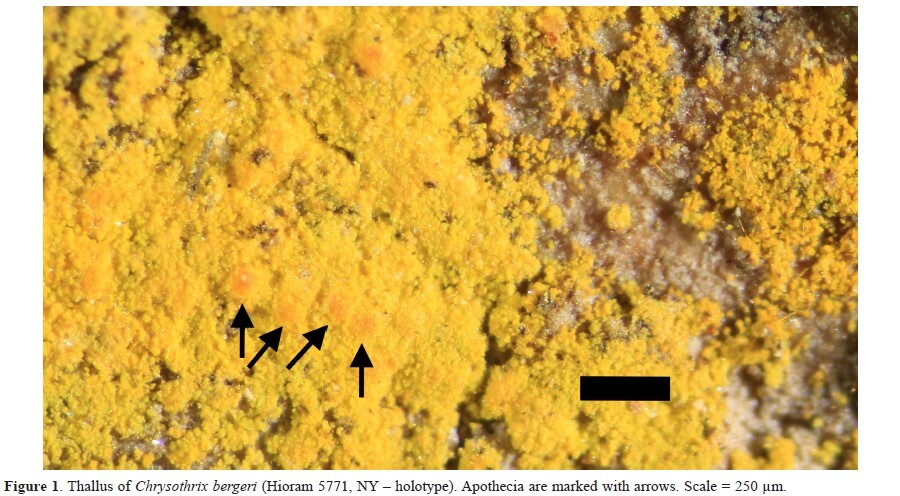ORIGINAL ARTICLE
Chrysothrix bergeri (Ascomycota: Arthoniales: Chrysothricaceae),
a new lichen species from the southeastern United States,
the Caribbean, and Bermuda
1
Department of Biological Sciences, 137 Biological Sciences Building,
130 Science Drive, Box 90338, Duke University, North Carolina
27708-0338, USA
Online publication date: 2020-12-29
Publication date: 2020-12-29
Plant and Fungal Systematics 2020; 65(2): 509-514
KEYWORDS
ABSTRACT
A crustose lichen species new to science – previously characterized in the literature
but unnamed – is formally described. This new species, Chrysothrix bergeri sp. nov.,
ranges from the southeastern United States southwards to the Caribbean islands (Bahamas
and Cuba) and eastwards to Bermuda. It is most easily confused with C. xanthina, from
which it differs in both chemistry and ascospore shape. Bilimbia aurata and Bilimbia stevensoni
are both confirmed as synonyms of C. xanthina. A lectotype is selected for Bilimbia
aurata. Solvent E is recommended for the chromatographic separation of leprapinic and
pinastric acids – two lichen secondary products critical for diagnosing certain species of
Chrysothrix, including C. bergeri.
REFERENCES (17)
1.
Aptroot, A., Sparrius, L., LaGreca, S. & Bungartz, F. 2008. Angiactis, a new crustose lichen genus in the family Roccellaceae with species from Bermuda, the Galápagos Islands, and Tasmania. The Bryologist 111: 510–516.
2.
Berger, F. & Aptroot, A. 2008. Bactrospora flavopruinosa, a new lichen species from Bermuda. The Lichenologist 40: 543–547.
3.
Berger, F. & LaGreca, S. 2014. Contributions to the lichen flora of Bermuda – Part I. New records, new combinations, and interesting collections of lichenized ascomycetes. Evansia 31: 41–68.
4.
Berger, F., LaGreca, S. & Aptroot, A. 2016. Lithothelium bermudense sp. nov., a new saxicolous lichen from Bermuda. Mycotaxon 131: 527–533.
5.
Culberson, C. F. & Ammann, K. 1979. Standardmethode zur Dünnschichtchromatographie von Flechtensubstanzen. Herzogia 5: 1–24.
6.
Culberson, C. F. & Johnson, A. 1982. Substitution of methyl tert-butyl ether for diethyl ether in the standardized thin-layer chromatographic method for lichen products. Journal of Chromatography 128: 253–259.
7.
Elix, J. A. & Crook, C. E. 1992. The joint occurrence of chloroxanthones in lichens, and a further thirteen new lichen xanthones. The Bryologist 95: 52–64.
8.
Fletcher, A. & W. O. Purvis. Chrysothrix. In: Smith C. W., Aptroot, A., B. J. Coppins B. J., O. L. Gilbert, P. W. James & Wolseley, P. A. 2009 (eds). The Lichens of Great Britain and Ireland (2nd edition), pp. 208–309. British Lichen Society, London.
9.
Harris, R. C. & Ladd, D. 2008. The lichen genus Chrysothrix in the Ozark ecoregion, including a preliminary treatment with for eastern and central North America. Opuscula Philolichenum 5: 29–42.
10.
Kalb, K. 2001. New or otherwise interesting lichens. I. Bibliotheca Lichenologica 78: 141–167.
11.
Kukwa M. & Knudsen, K. 2011. Notes on the identity of Chrysothrix populations (Arthoniales, Ascomycota) containing pinastric acid from southern and central California. Mycotaxon 116: 407–411.
13.
Lendemer, J. C. & Noell, N. 2018. Delmarva Lichens: An illustrated manual. Memoirs of the Torrey Botanical Society 28: 1–386.
14.
Lendemer, J. C., Harris, R. C. & Ruiz, A. M. 2016. A review of the lichens of the Dare Regional Biodiversity Hotspot in the Mid-Atlantic Coastal Plain of North Carolina, eastern North America. Castanea 81: 1–77.
15.
Olszewska, S., Zwolicki, A., & Kukwa, M. 2014. Chemistry and morphology of Chrysothrix candelaris in Poland, with notes on the taxonomy of C. xanthina. Mycotaxon 128: 165–172.
16.
Riddle, L. W. 1920. Lichens. In: N. L. Britton & C. F. Millspaugh (eds), The Bahama Flora, pp. 522–553. Published by the authors.
17.
Tønsberg, T. 1992. The sorediate and isidiate, corticolous, crustose lichens in Norway. Sommerfeltia 14: 1–331.
CITATIONS (2):
1.
Lichen Diversity on an Arborescent Runner Oak (Quercus pumila) in South Florida, USA
Scott LaGreca, Gary Perlmutter, Douglas Goldman, Frederick Seavey, Jean Seavey
Evansia
Scott LaGreca, Gary Perlmutter, Douglas Goldman, Frederick Seavey, Jean Seavey
Evansia
2.
Diploicia christinae sp. nov. (Ascomycota: Caliciales: Caliciaceae), an overlooked lichen species from Bermuda
Scott LaGreca
Plant and Fungal Systematics
Scott LaGreca
Plant and Fungal Systematics
Share
RELATED ARTICLE
We process personal data collected when visiting the website. The function of obtaining information about users and their behavior is carried out by voluntarily entered information in forms and saving cookies in end devices. Data, including cookies, are used to provide services, improve the user experience and to analyze the traffic in accordance with the Privacy policy. Data are also collected and processed by Google Analytics tool (more).
You can change cookies settings in your browser. Restricted use of cookies in the browser configuration may affect some functionalities of the website.
You can change cookies settings in your browser. Restricted use of cookies in the browser configuration may affect some functionalities of the website.



